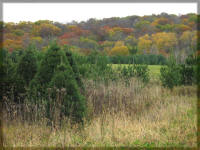| To skip the descriptions and see a few photos, scroll down.
Most Christmas trees come in three different groups of conifers, the pines, spruces, and firs. We believe strongly in diversity for both customer choice and sustainability reasons, and so we grow: white, red, and scotch pines, white, blue, norway, and black hills spruce, and balsam and fraser fir.
Pines are longer-needled trees, while spruce and fir are generally have shorter needles. Among the pines, scotch pine have the shortest needles, while red and white pine have longer needles. White pine needles and braches are quite soft, while red and scotch pine are harder and more prickly. Red and white pines are native to North America, but scotch pine (native throughout much of Europe) has been one of the most widely grown Christmas trees in the U.S.
Spruce needles are generally stiffer and so more prickly than fir, but otherwise they are more similar to each other than the pines largely because of their shorter needles. Both can be full or more open, allowing room for more ornaments. Both naturally grow in the Christmas tree shape. And while fir holds needles better than spruce when dry (both do well when maintained fresh), the generally stiffer branches of spruce hold heavier ornaments (or even candles, as in scandinavia, where the norway spruce is traditional).
Below we provide a few fotos of different Christmas tree species taken on our farm. You can find plenty more information on the web, including at the National Christmas Tree Association web site.
Click on a picture to see a larger version.
  
white pine red pine scotch pine
  
norway spruce white spruce balsam fir
Though these pictures all show fairly full trees, we do have some spruce and fir that are more open and "natural-grown", and we are moving in that direction with a larger portion of our short-needled (spruce and fir) trees.
 This last foto is fairly typical of our farm - a diversity of Christmas trees mixed with wildness (diverse, unsprayed and unmowed ground cover, thickets, unmanaged pines and hardwoods), intermixed with hay and pasture and surrounded by woods. (OK, so the woods aren't always that colorful ...) This last foto is fairly typical of our farm - a diversity of Christmas trees mixed with wildness (diverse, unsprayed and unmowed ground cover, thickets, unmanaged pines and hardwoods), intermixed with hay and pasture and surrounded by woods. (OK, so the woods aren't always that colorful ...)
|

